Empirical Evaluation of the Possible Contribution of Group Practice of the Transcendental Meditation and TM-Sidhi Program to Reduction in Drug-Related Mortality
Abstract
1. Introduction
1.1. The Epidemic of U.S. Drug-Related Mortality
1.2. U.S. Epidemic of Stress
1.3. Structure of the Paper
2. Consciousness-Based Approach to Decreasing Drug-Related Mortality
2.1. Transcendental Meditation Technique
2.2. Research on Health-Related Behavioral Effects of TM Practice
2.3. Reduction of Societal Stress and Its Effects
2.4. Principles from Ancient and Contemporary Theorists
2.5. The Concept of Collective Consciousness: Historical Precedents and Contemporary Examples
2.6. Prior Empirical Research on the Current Social Experiment
3. Other Previous Empirical Research on the Maharishi Effect
3.1. Research on Public Health Related Indicators: City Level
3.2. Research on Public Health Related Indicators: Province or State Level
3.3. Research on Public Health Related Indicators: National Level
4. Methods
4.1. Data Definitions and Sources
4.2. Interrupted Time Series (ITS) Research Design
4.3. Prospective Social Experiment
4.4. Baseline, Demonstration, and Follow-Up Periods
4.5. Testable Hypotheses Examined in the Current Study
4.6. Time Series Plots of Data
4.7. Segmented-Trend Regression Model
+ seasonal component + εT, T = 0, 1, 2,…, 179
4.8. Model Estimation
5. Results
5.1. Estimated Regression Model
| LM test for no serial correlation 1: Lags 1–2: F(2, 157) = 2.925 (p = 0.057) Lags 1–7: F(7, 152) = 1.409 (p = 0.205) | LM test for no heteroscedasticity 2: F(22, 154) = 1.423 (p = 0.112) |
| LM test for normality 3: χ2 = 2.776 (p = 0.250) | LM test for no ARCH 4: Lags 1–7: F(7, 166) = 1.286 (p = 0.260) |
| HML test for stationarity 5: z = −0.942 (p = 0.70) | KPSS test for stationarity 6: test statistic = 0.0518 (p ≤ 0.88) |
5.2. Diagnostic Tests
5.3. Long-Run Estimates of Regression Coefficients
5.4. Tests of Research Hypotheses
5.5. Sensitivity Analyses
6. Discussion
6.1. Summary of Empirical Results
6.2. Alternative Possible Explanations for the Empirical Results
6.3. Possible Mechanism of Action
6.4. Possible Causal Interpretation
7. Conclusions
Supplementary Materials
Author Contributions
Funding
Institutional Review Board Statement
Informed Consent Statement
Data Availability Statement
Acknowledgments
Trademarks
Conflicts of Interest
References
- Commission on Combating Synthetic Opioid Trafficking. Commission on Combating Synthetic Opioid Trafficking: Final Report. Santa Monica, CA: The RAND Corporation. 2022. Available online: https://www.rand.org/pubs/external_publications/EP68838.html (accessed on 15 January 2023).
- Lopez, G.; A Rising Death Toll. The New York Times: The Morning. Available online: https://www.nytimes.com/2022/02/13/briefing/opioids-drug-overdose-death-toll.html (accessed on 15 January 2023).
- Centers for Disease Control and Prevention; National Center for Health Statistics. Drug Overdose Deaths in the U.S. Top 100,000 Annually (Press Release). Available online: https://www.cdc.gov/nchs/pressroom/nchs_press_releases/2021/20211117.htm (accessed on 15 January 2023).
- American Medical Association. 2021 Overdose Epidemic Report. AMA: Chicago, IL, USA. Available online: https://end-overdose-epidemic.org/wp-content/uploads/2021/09/AMA-2021-Overdose-Epidemic-Report_92021.pdf (accessed on 15 January 2023).
- Centers for Disease Control and Prevention. Drug Overdose Deaths Remain High. 2022. Available online: https://www.cdc.gov/drugoverdose/deaths/index.html (accessed on 15 January 2023).
- Fink, G. Stress, definitions, mechanisms, and effects outlined: Lessons from anxiety. In Handbook of Stress, Vol. 1. Stress: Concepts, Cognition, Emotion, and Behavior; Fink, G., Ed.; Academic Press: London, UK, 2016; pp. 3–11. [Google Scholar]
- American Psychological Association. Inflation, War Push Stress to Alarming Levels at Two-Year COVID-19 Anniversary. Available online: https://www.apa.org/news/press/releases/2022/03/inflation-war-stress (accessed on 15 January 2023).
- Abramson, A. Burnout and Stress Are Everywhere. American Psychological Association 2022 Trends-Report. 53, p. 72. Available online: https://www.apa.org/monitor/2022/01/special-burnout-stress (accessed on 15 January 2023).
- World Health Organization. Burn-Out an “Occupational Phenomenon”: International Classification of Diseases. Available online: https://www.who.int/news/item/28-05-2019-burn-out-an-occupational-phenomenon-international-classification-of-diseases (accessed on 28 May 2019).
- Linsky, A.S.; Bachman, R.; Strauss, M. Stress, Culture, and Aggression; Yale University Press: New Haven, CT, USA, 1995. [Google Scholar]
- Holmes, T.H.; Masuda, M. Life changes and illness susceptibility. In Stressful Life Events: Their Nature and Effects; Dohrenwend, B.S., Dohrenwend, B.P., Eds.; Wiley: Hoboken, NJ, USA, 1974; pp. 45–72. [Google Scholar]
- Linsky, A.S.; Strauss, M.A. Social Stress in the United States: Links to Regional Patterns in Crime and Illness; Praeger: Westport, CT, USA, 1986. [Google Scholar]
- Dillbeck, M.C.; Cavanaugh, K.L. Group practice of the Transcendental Meditation® and TM-Sidhi® program and reductions in infant mortality and drug-related death: A quasi-experimental analysis. SAGE Open 2017, 7, 1–15. [Google Scholar] [CrossRef]
- Maharishi Mahesh Yogi. Maharishi Mahesh Yogi on the Bhagavad-Gita: A New Translation and Commentary, Chapters 1–6; Penguin: Baltimore, MD, USA, 1969. [Google Scholar]
- Roth, B. Strength in Stillness: The Power of Transcendental Meditation; Simon & Schuster: New York, NY, USA, 2018. [Google Scholar]
- Travis, F.; Shear, J. Focused attention, open monitoring and automatic self-transcending: Categories to organize meditations from Vedic, Buddhist and Chinese traditions. Conscious. Cogn. 2010, 19, 1110–1118. [Google Scholar] [CrossRef] [PubMed]
- Dillbeck, M.C.; Barnes, V.A.; Schneider, R.H.; Travis, F.T. (Eds.) Scientific Research on the Transcendental Meditation and TM-Sidhi Programme: Collected Papers; Maharishi Vedic University Press: Vlodrop, The Netherlands, 2020; Volume 8. [Google Scholar]
- Travis, F.; Pearson, C. Pure consciousness: Distinct phenomenological and physiological correlates of “Consciousness Itself”. Int. J. Neurosci. 2000, 100, 77–89. [Google Scholar] [CrossRef] [PubMed]
- Dillbeck, M.C.; Orme-Johnson, D.W. Physiological differences between Transcendental Meditation and rest. Am. Psychol. 1987, 42, 879–881. [Google Scholar] [CrossRef]
- Dillbeck, M.C.; Bronson, E.C. Short-term longitudinal effects of the Transcendental Meditation technique on EEG power and coherence. Int. J. Neurosci. 1981, 14, 147–151. [Google Scholar] [CrossRef]
- Travis, F.; Haaga, D.A.F.; Hagelin, J.; Tanner, M.; Arenander, A.; Nidich, S.; Schneider, R.H. A self-referential default brain state: Patterns of coherence, power, and eLORETA sources during eyes-closed rest and Transcendental Meditation practice. Cogn. Process. 2010, 11, 21–30. [Google Scholar] [CrossRef]
- Travis, F.; Arenander, A. Cross-sectional and longitudinal study of effects of Transcendental Meditation practice on interhemispheric frontal asymmetry and frontal coherence. Int. J. Neurosci. 2006, 116, 1519–1538. [Google Scholar] [CrossRef]
- Yamamoto, S.; Kitamura, Y.; Yamada, N.; Nakashima, Y.; Kuroda, S. Medial prefrontal cortex and anterior cingulated cortex in the generation of alpha activity induced by Transcendental Meditation: A magnetoencephalographic study. Acta Med. Okayama 2006, 60, 51–58. [Google Scholar] [CrossRef]
- Travis, F.; Haaga, D.A.F.; Hagelin, J.; Tanner, M.; Nidich, S.; Gaylord-King, C.; Schneider, R.H. Effects of Transcendental Meditation practice on brain functioning and stress reactivity in college students. Int. J. Psychophysiol. 2009, 71, 170–176. [Google Scholar] [CrossRef]
- Jevning, R.; Wilson, A.F.; Davidson, J.M. Adrenocortical activity during meditation. Horm. Behav. 1978, 10, 54–60. [Google Scholar] [CrossRef]
- MacLean, C.R.K.; Walton, K.G.; Wenneberg, S.R.; Levitsky, D.K.; Mandarino, J.V.; Waziri, R.; Schneider, R.H. Effects of the Transcendental Meditation program on adaptive mechanisms: Changes in hormone levels and responses to stress after 4 months of practice. Psychoneuroendocrinology 1997, 22, 277–295. [Google Scholar] [CrossRef]
- Walton, K.G.; Fields, J.Z.; Levitsky, D.K.; Harris, D.A.; Pugh, N.D.; Schneider, R.H. Lowering cortisol and CVD risk in postmenopausal women: A pilot study using the Transcendental Meditation program. Ann. N. Y. Acad. Sci. 2004, 1032, 211–215. [Google Scholar] [CrossRef]
- Nidich, S.; Mills, P.J.; Rainforth, M.; Heppner, P.; Schneider, R.H.; Rosenthal, N.E.; Rutledge, T. Non-trauma-focused meditation versus exposure therapy in veterans with post-traumatic stress disorder: A randomised controlled trial. Lancet Psychiatry 2018, 5, 975–986. [Google Scholar] [CrossRef]
- Orme-Johnson, D.W.; Barnes, V.A. Effects of the Transcendental Meditation technique on trait anxiety: A meta-analysis of randomized controlled trials. J. Altern. Complement. Med. 2014, 20, 330–341. [Google Scholar] [CrossRef]
- Hawkins, M.A.; Orme-Johnson, D.W.; Durchholz, C.F. Fulfilling the rehabilitative ideal through the Transcendental Meditation and TM-Sidhi programs: Primary, secondary, and tertiary prevention. J. Soc. Behav. Personal. 2005, 17, 443–488. [Google Scholar]
- Rainforth, M.V.; Alexander, C.N.; Cavanaugh, K.L. Effects of the Transcendental Meditation program on recidivism among former inmates of Folsom Prison: Survival analysis of 15-year follow-up data. J. Offender Rehabil. 2003, 36, 181–203. [Google Scholar] [CrossRef]
- Bonamer, J.; Aquino-Russel, C. Self-care strategies for professional development: Transcendental Meditation reduces compassion fatigue and improves resilience for nurses. J. Nurses Prof. Development. 2019, 35, 93–97. [Google Scholar] [CrossRef]
- Valosek, L.; Wendt, S.; Link, J.; Abrams, A.; Hipps, J.; Grant, J.; Nidich, S. Meditation effective in reducing teacher burnout and improving resilience: A randomized controlled study. Front. Educ. 2021, 6, 1–6. [Google Scholar] [CrossRef]
- Alexander, C.N.; Davies, J.L.; Dixon, C.A.; Dillbeck, M.C.; Druker, S.M.; Oetzel, R.M.; Orme-Johnson, D.W. Growth of higher states of consciousness: Maharishi’s Vedic psychology of human development. In Higher Stages of Human Development: Perspectives on Adult Growth; Alexander, C.N., Langer, E.J., Eds.; Oxford University Press: New York, NY, USA, 1990; pp. 286–341. [Google Scholar]
- Dillbeck, M.C.; Alexander, C.N. Higher States of Consciousness: Maharishi Mahesh Yogi’s Vedic Psychology of Human Development. J. Mind Behav. 1989, 10, 307–334. Available online: https://www.jstor.org/stable/43853469 (accessed on 15 January 2023).
- Anderson, J.W.; Liu, C.; Kryscio, R.J. Blood pressure response to Transcendental Meditation: A meta-analysis. Am. J. Hypertens. 2008, 21, 310–316. [Google Scholar] [CrossRef]
- Bai, Z.; Chang, J.; Chen, C.; Li, P.; Yang, K.; Chi, I. Investigating the effect of Transcendental Meditation on blood pressure; A systematic review and meta-analysis. J. Hum. Hypertens. 2015, 29, 653–662. [Google Scholar] [CrossRef] [PubMed]
- Rainforth, M.V.; Schneider, R.H.; Nidich, S.I.; Gaylord-King, C.; Salerno, J.W.; Anderson, J.W. Stress reduction programs in patients with elevated blood pressure: A systematic review and meta-analysis. Curr. Hypertens. Rep. 2007, 9, 520–528. [Google Scholar] [CrossRef] [PubMed]
- Schneider, R.H.; Grim, C.E.; Rainforth, M.V.; Kotchen, T.; Nidich, S.I.; Gaylord-King, C.; Alexander, C.N. Stress reduction in the secondary prevention of cardiovascular disease: Randomized, controlled trial of Transcendental Meditation and health education in Blacks. Circ. Cardiovasc. Qual. Outcomes 2012, 5, 750–758. [Google Scholar] [CrossRef] [PubMed]
- Schneider, R.H.; Carr, T. Transcendental Meditation in the prevention and treatment of cardiovascular disease and pathophysiological mechanisms: An evidence-based review. Adv. Integr. Med. 2014, 1, 107–112. [Google Scholar] [CrossRef]
- Hawkins, M.A. Effectiveness of the Transcendental Meditation program in criminal rehabilitation and substance abuse recovery: A review of the research. J. Offender Rehabil. 2003, 36, 47–65. [Google Scholar] [CrossRef]
- Alexander, C.N.; Robinson, P.; Rainforth, M. Treating and preventing alcohol, nicotine, and drug abuse through Transcendental Meditation: A review and statistical meta-analysis. Alcohol. Treat. Q. 1994, 11, 13–87. [Google Scholar] [CrossRef]
- Walton, K.G.; Levitsky, D. A neuroendocrine mechanism for the reduction of drug use and addictions by Transcendental Meditation. Alcohol. Treat. Q. 1994, 11, 89–117. [Google Scholar] [CrossRef]
- Cavanaugh, K.L.; Dillbeck, M.C.; Orme-Johnson, D.W. Evaluating a field theory of consciousness and social change: Group practice of Transcendental Meditation and homicide trends. Stud. Asian Soc. Sci. 2022, 8, 1–32. [Google Scholar] [CrossRef]
- Katz, V. Conversations with Maharishi: Maharishi Mahesh Yogi Speaks about the Full Development of Human Consciousness (Vol. 1); Maharishi University of Management Press: Fairfield, IA, USA, 2011. [Google Scholar]
- Maharishi Mahesh Yogi. Life Supported by Natural Law; Age of Enlightenment Press: Washington, DC, USA, 1986. [Google Scholar]
- Nader, T. One Unbounded Ocean of Consciousness: Simple Answers to the Big Questions in Life; audio book edition; Penguin Random House Group: New York, NY, USA, 2021. [Google Scholar]
- Hagelin, J.S. Is consciousness the unified field? A field theorist’s perspective. Mod. Sci. Vedic Sci. 1987, 1, 28–87. Available online: https://www.miu.edu/wp-content/uploads/sites/2/2014/07/hagelin.pdf (accessed on 15 January 2023).
- Shadish, W.R.; Cook, T.D.; Campbell, D.T. Experimental and Quasi-Experimental Designs for Generalized Causal Inference; Houghton Mifflin: Boston, MA, USA, 2002. [Google Scholar]
- Nader, T. Consciousness is all there is: A mathematical approach with applications. Int. J. Math. Conscious. 2015, 1, 1–65. Available online: http://ijmac.miu.edu/index.php/test/issue/view/1/1 (accessed on 15 January 2023).
- Maharishi Mahesh Yogi. Inauguration of the Dawn of the Age of Enlightenment; Maharishi International University Press: Wünsdorf, Germany, 1975. [Google Scholar]
- Maharishi Mahesh Yogi. Creating an Ideal Society; MERU Press: Wünsdorf, Germany, 1977. [Google Scholar]
- Maharishi European Research University. Alliance with Natural Law for National Self-Reliance: A Proposal and Invitation to Every Government from the World Government of the Age of Enlightenment; MERU Press: Wünsdorf, Germany, 1982. [Google Scholar]
- Maharishi Mahesh Yogi. Enlightenment to Every Individual, Invincibility to Every Nation; MERU Press: Wünsdorf, Germany, 1978. [Google Scholar]
- Maharishi University of Natural Law. Alliance with Natural Law: A Simple Solution to All International Problems of U.N.O. and National Problems of Every Government; MERU Press: Seelisberg, Switzerland, 1982. [Google Scholar]
- Durkheim, E. Suicide: A Study in Sociology; Free Press: Glencoe, IL, USA, 1951. [Google Scholar]
- Lukes, S. Emile Durkheim, His Life and Work: A Historical and Critical Study; Allen Lane: London, UK, 1973. [Google Scholar]
- McDougall, W. The Group Mind; Cambridge University Press: Cambridge, UK, 1920. [Google Scholar]
- James, W. Human Immortality; Houghton-Mifflin: Boston, MA, USA, 1977. [Google Scholar]
- Nelson, R.D. Connected: The Emergence of Global Consciousness; ICRL Press: Princeton, NJ, USA, 2019. [Google Scholar]
- Edmans, A.; Fernandez-Perez, A.; Garel, A.; Indriawan, I. Music sentiment and stock returns around the world. J. Financ. Econ. 2022, 145, 234–254. [Google Scholar] [CrossRef]
- Cohen, J. Statistical Power Analysis for the Behavioral Sciences, 2nd ed.; Routledge: New York, NY, USA, 1988. [Google Scholar]
- Dillbeck, M.C.; Cavanaugh, K.L. Societal violence and collective consciousness: Reduction of U.S. homicide and urban violent crime rates. SAGE Open 2016, 6, 1–16. [Google Scholar] [CrossRef]
- Cavanaugh, K.L.; Dillbeck, M.C. The contribution of proposed field effects of consciousness to the prevention of US accidental fatalities: Theory and empirical tests. J. Conscious. Stud. 2017, 24, 53–86. Available online: https://www.ingentaconnect.com/contentone/imp/jcs/2017/00000024/F0020001/art00003 (accessed on 15 January 2023).
- Cavanaugh, K.L.; Dillbeck, M.C. Field effects of consciousness and reduction in U.S. urban murder rates: Evaluation of a prospective quasi-experiment. J. Health Environ. Res. 2017, 3, 32–43. [Google Scholar]
- Grissom, R.J.; Kim, J.J. Effect Sizes for Research: Univariate and Multivariate Applications, 2nd ed.; Routledge: New York, NY, USA, 2012. [Google Scholar]
- Darlington, R.B.; Hayes, A.F. Regression Analysis and Linear Models: Concepts, Applications, and Implementation; Guilford Publications: New York, NY, USA, 2017. [Google Scholar]
- Linden, A. Conducting interrupted time-series analysis for single- and multiple-group comparisons. Stata J. 2015, 15, 480–500. [Google Scholar] [CrossRef]
- Linden, A. A comprehensive set of postestimation measures to enrich interrupted time-series analysis. Stata J. 2017, 17, 73–88. [Google Scholar] [CrossRef]
- Orme-Johnson, D.W.; Cavanaugh, K.L.; Dillbeck, M.C.; Goodman, R.S. Field-effects of consciousness: A seventeen-year study of the effects of group practice of Transcendental Meditation and TM-Sidhi programs on reducing national stress in the United States. World J. Soc. Sci. 2022, 9, 1–38. [Google Scholar] [CrossRef]
- Dillbeck, M.C.; Banus, C.B.; Polanzi, C.; Landrith, G.S., III. Test of a field model of consciousness and social change: The Transcendental Meditation and TM-Sidhi program and decreased urban crime. J. Mind Behav. 1988, 9, 457–485. Available online: https://www.jstor.org/stable/43853459 (accessed on 15 January 2023).
- Hagelin, J.S.; Rainforth, M.V.; Orme-Johnson, D.W.; Cavanaugh, K.L.; Alexander, C.N.; Shatkin, S.; Davies, J.L.; Hughes, A.O.; Ross, E. Effects of group practice of the Transcendental Meditation program on preventing violent crime in Washington, D.C.: Results of the National Demonstration Project, June–July, 1993. Soc. Indic. Res. 1999, 47, 153–201. [Google Scholar] [CrossRef]
- Hatchard, G.D.; Deans, A.J.; Cavanaugh, K.L.; Orme-Johnson, D.W. The Maharishi Effect: A model for social improvement. Time series analysis of a phase transition to reduced crime in Merseyside Metropolitan Area. Psych. Crime & Law 1996, 2, 165–174. [Google Scholar] [CrossRef]
- Orme-Johnson, D.W.; Alexander, C.N.; Davies, J.L.; Chandler, H.M.; Larimore, W.E. International peace project in the Middle East: The effects of the Maharishi Technology of the Unified Field. J. Confl. Resolut. 1988, 32, 776–812. [Google Scholar] [CrossRef]
- Box, G.E.P.; Jenkins, G. Time Series Analysis: Forecasting and Control; Holden-Day: San Francisco, CA, USA, 1976. [Google Scholar]
- McCleary, R.; McDowall, D.; Bartos, B.J. Design and Analysis of Time Series Experiments; Oxford University Press: New York, NY, USA, 2017. [Google Scholar]
- Fales, E.; Markovsky, B. Evaluating heterodox theories. Soc. Forces 1997, 76, 511–525. [Google Scholar] [CrossRef]
- Schrodt, P.A. A methodological critique of a test of the effects of the Maharishi Technology of the Unified Field. J. Confl. Resolut. 1990, 34, 745–755. [Google Scholar] [CrossRef]
- Orme-Johnson, D.W.; Alexander, C.N.; Davies, J.L. The effects of the Maharishi Technology of the Unified Field: Reply to a methodological critique. J. Confl. Resolut. 1990, 34, 756–768. [Google Scholar] [CrossRef]
- Orme-Johnson, D.W.; Oates, R.M. A field-theoretic view of consciousness: Reply to critics. J. Sci. Explor. 2009, 23, 139–166. Available online: https://www.scientificexploration.org/docs/23/jse_23_2_johnson.pdf (accessed on 15 January 2023).
- Box, G.E.P.; Tiao, G.C. Intervention analysis with applications to economic and environmental problems. J. Am. Stat. Assoc. 1975, 70, 70–79. [Google Scholar] [CrossRef]
- Dillbeck, M.C.; Cavanaugh, K.L.; Glenn, T.; Orme-Johnson, D.W.; Middlefehlt, V. Consciousness as a field: The Transcendental Meditation and TM-Sidhi program and changes in social indicators. J. Mind Behav. 1987, 8, 67–103. Available online: https://www.jstor.org/stable/43853335 (accessed on 15 January 2023).
- Dillbeck, M.C. Test of a field theory of consciousness and social change: Time series analysis of participation in the TM-Sidhi program and reduction of violent death in the U.S. Soc. Indic. Res. 1990, 22, 399–418. [Google Scholar] [CrossRef]
- Davies, J.L.; Alexander, C.N. Alleviating political violence through reducing collective tension: Impact assessment analyses of the Lebanon war. J. Soc. Behav. Personal. 2005, 17, 285–338. Available online: https://www.gusp.org/pdf/JSBP-davies-alex-2005.pdf (accessed on 15 January 2023).
- Centers for Disease Control and Prevention; National Center for Health Statistics. Multiple Cause of Death 1999–2016 on CDC WONDER Online Database (Released December 2017). 2018. Available online: http://wonder.cdc.gov/ucd-icd10.html (accessed on 5 January 2018).
- U.S. Bureau of Economic Analysis (2017). Population [POPTHM]. FRED, Federal Reserve Bank of St. Louis. Available online: https://fred.stlouisfed.org/series/POPTHM (accessed on 12 October 2017).
- Campbell, D.T.; Stanley, J.C. Experimental and Quasi-Experimental Designs for Research; Rand McNally: Chicago, IL, USA, 1966. [Google Scholar]
- Cook, T.D.; Campbell, D.T. Quasi-Experimentation: Design & Analysis Issues for Field Settings; Houghton Mifflin: Boston, MA, USA, 1979. [Google Scholar]
- Glass, G.V. Interrupted time series quasi-experiments. In Complementary Methods for Research in Education, 2nd ed.; Jaeger, R.M., Ed.; American Educational Research Association: Washington, DC, USA, 1997; pp. 589–608. [Google Scholar]
- Huitema, B.E.; McKean, J.W. Design specification issues in time-series intervention models. Educ. Psychol. Meas. 2000, 60, 38–58. [Google Scholar] [CrossRef]
- Marsh, L.C.; Cormier, D.R. Spline Regression Models; Sage: Thousand Oaks, CA, USA, 2002. [Google Scholar]
- Mitchell, M.N. Interpreting and Visualizing Regression Models Using Stata; Stata Press: College Station, TX, USA, 2012. [Google Scholar]
- Pankratz, A. Forecasting with Dynamic Regression Models; Wiley: New York, NY, USA, 1991. [Google Scholar]
- Lewis-Beck, M.S. Interrupted time series. In New Tools for Social Scientists: Advances and Applications in Research Methods; Berry, W.D., Lewis-Beck, M.S., Eds.; Sage: Beverly Hills, CA, USA, 1986; pp. 209–240. [Google Scholar]
- StataCorp. Stata Statistical Software: Release 16; StataCorp LLC.: College Station, TX, USA, 2019. [Google Scholar]
- Doornik, J.A.; Hendry, D.F. Modelling Dynamic Systems: PcGive 15 (Vol. 2); Timberlake Consultants, Ltd.: London, UK, 2018. [Google Scholar]
- Newey, W.K.; West, K.D. A simple, positive semi-definite, heteroskedasticity and autocorrelation consistent covariance matrix. Econometrica 1987, 55, 703–708. [Google Scholar] [CrossRef]
- Doornik, J.A.; Hendry, D.F. Empirical Econometric Modelling: PcGive 15 (Vol. 1); Timberlake Consultants, Ltd.: London, UK, 2018. [Google Scholar]
- Davidson, J. Time Series Modelling Version 4.51: Models and Methods. 2019. Available online: http://www.timeseriesmodelling.com (accessed on 21 December 2020).
- Brockwell, P.J.; Davis, R.A. Introduction to Time Series and Forecasting, 3rd ed.; Springer: New York, NY, USA, 2016. [Google Scholar]
- Schwarz, G. Estimating the dimension of a model. Ann. Stat. 1978, 6, 461–464. [Google Scholar] [CrossRef]
- Harris, D.; McCabe, B.; Leybourne, S. Testing for long memory. Econom. Theory 2008, 24, 143–175. [Google Scholar] [CrossRef]
- Breusch, T.S. Testing for autocorrelation in dynamic linear models. Aust. Econ. Pap. 1978, 17, 334–355. [Google Scholar] [CrossRef]
- Cumby, R.E.; Huizinga, J. Testing the autocorrelation structure of disturbances in ordinary least squares and instrumental variables regressions. Econometrica 1992, 60, 185–195. [Google Scholar] [CrossRef]
- Baum, C.F.; Schaffer, M.E. ACTEST: Stata Module to Perform Cumby-Huizinga General Test for Autocorrelation in Time Series. Statistical Software Components S457668, Boston College Department of Economics. 2013. Available online: https://ideas.repec.org/c/boc/bocode/s457668.html (accessed on 15 January 2023).
- Banerjee, A.; Dolado, J.J.; Galbraith, J.W.; Hendry, D. Co-integration, Error Correction and the Econometric Analysis of Non-stationary Data; Oxford University Press: Oxford, UK, 1993. [Google Scholar]
- Pickup, M. Introduction to Time Series Analysis; Sage: Thousand Oaks, CA, USA, 2015. [Google Scholar]
- Enders, W. Applied Econometric Time Series, 4th ed.; Wiley: Hoboken, NJ, USA, 2014. [Google Scholar]
- Kwiatkowski, D.; Phillips, P.C.B.; Schmidt, P.; Shin, Y. Testing the null hypothesis of stationarity against the alternative of a unit root: How sure are we that economic time series have a unit root? J. Econom. 1992, 54, 159–178. [Google Scholar] [CrossRef]
- White, H. A heteroskedasticity-consistent covariance matrix estimator and a direct test for heteroskedasticity. Econometrica 1980, 48, 817–838. [Google Scholar] [CrossRef]
- Engle, R.F. Autoregressive conditional heteroscedasticity with estimates of the variance of United Kingdom inflation. Econometrica 1982, 50, 987–1007. [Google Scholar] [CrossRef]
- Doornik, J.A.; Hansen, H. An omnibus test for univariate and multivariate normality. Oxf. Bull. Econ. Stat. 2008, 70, 927–939. [Google Scholar] [CrossRef]
- Hendry, D.F. Dynamic Econometrics; Oxford University Press: Oxford, UK, 1995. [Google Scholar]
- Inder, B. Estimating long-run relationships in economics: A comparison of different approaches. J. Econom. 1993, 57, 53–68. [Google Scholar] [CrossRef]
- Bårdsen, G. The estimation of long-run coefficients from error-correcting models. Oxf. Bull. Econ. Statistics 1989, 51, 345–350. [Google Scholar] [CrossRef]
- Marzuk, P.M.; Tardiff, K.; Leon, A.C.; Hirsch, C.S.; Portera, L.; Iqbal, M.I.; Hartwell, N. Ambient temperature and mortality from unintentional cocaine overdose. JAMA 1998, 279, 1795–1800. [Google Scholar] [CrossRef] [PubMed]
- National Oceanic and Atmospheric Administration; National Centers for Environmental Information. (2020, September) Climate at a Glance: National Time Series. Available online: https://www.ncdc.noaa.gov/cag/ (accessed on 15 September 2020).
- Walton, K.G.; Cavanaugh, K.L.; Pugh, N.D. Effects of group practice of the Transcendental Meditation program on biochemical indicators of stress in non-meditators: A prospective time series study. J. Soc. Behav. Personal. 2005, 17, 339–373. Available online: https://www.gusp.org/wp-content/uploads/2021/08/JSBP-walton-cavanaugh-pugh-2005.pdf (accessed on 15 January 2023).
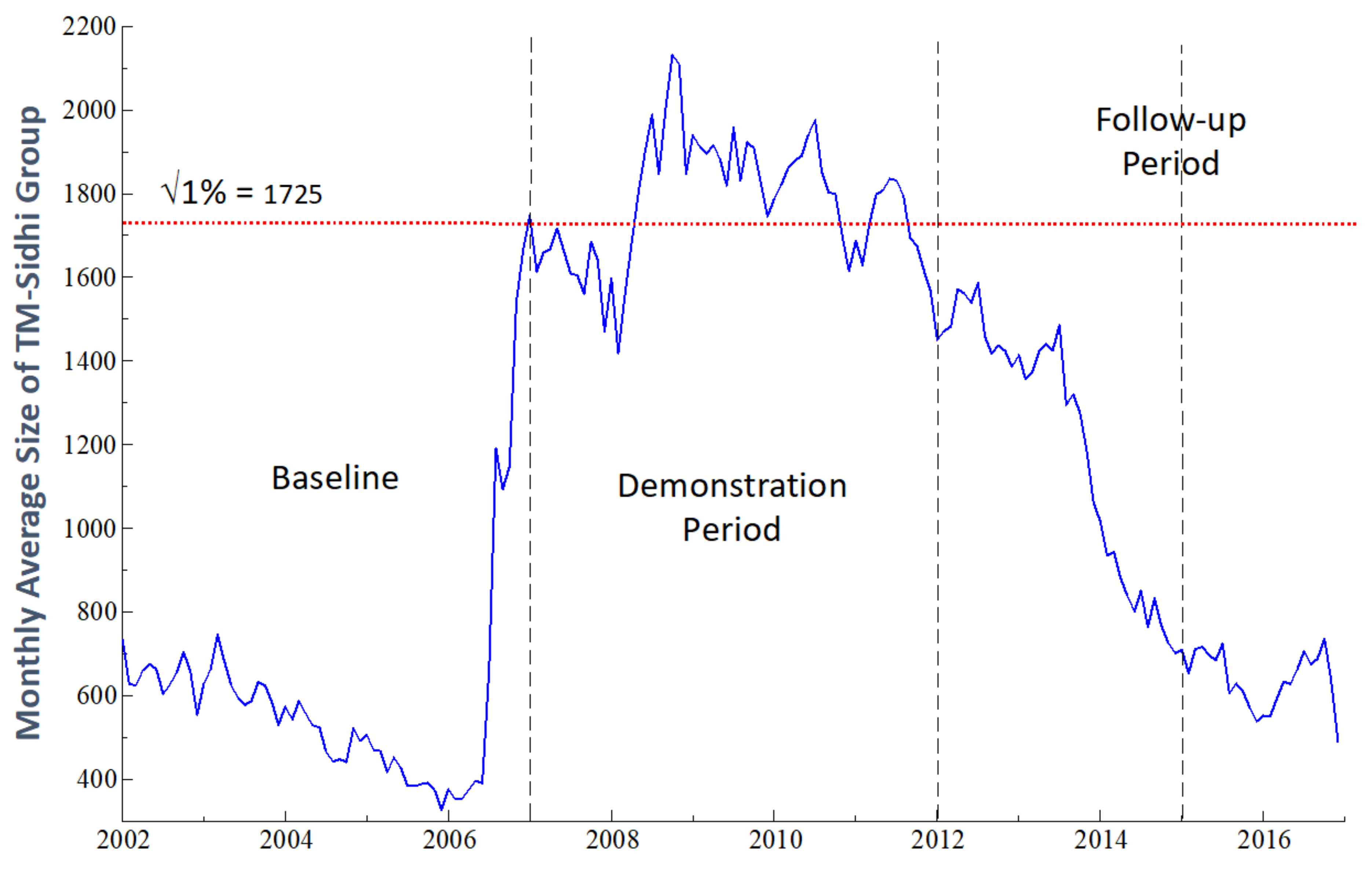
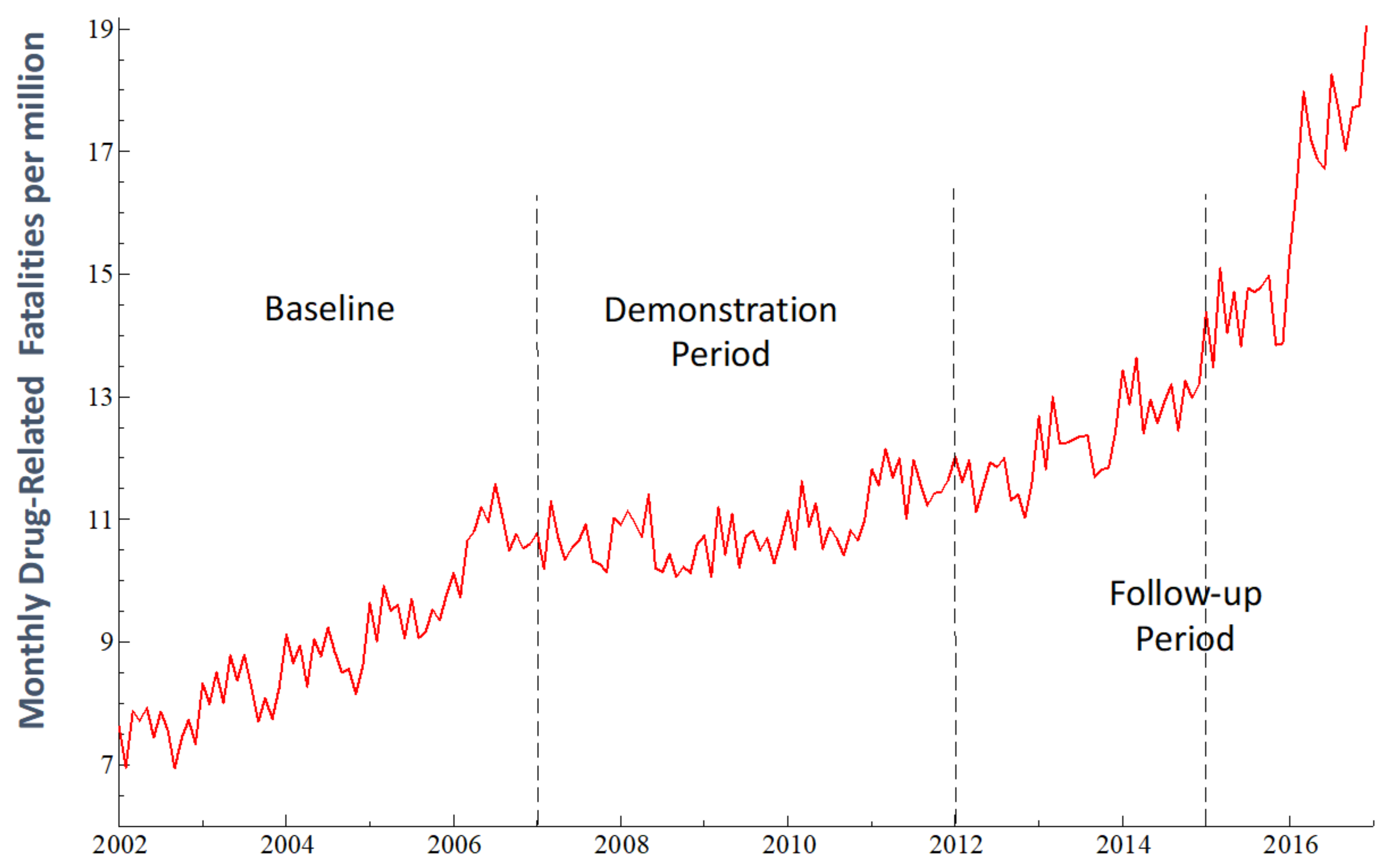
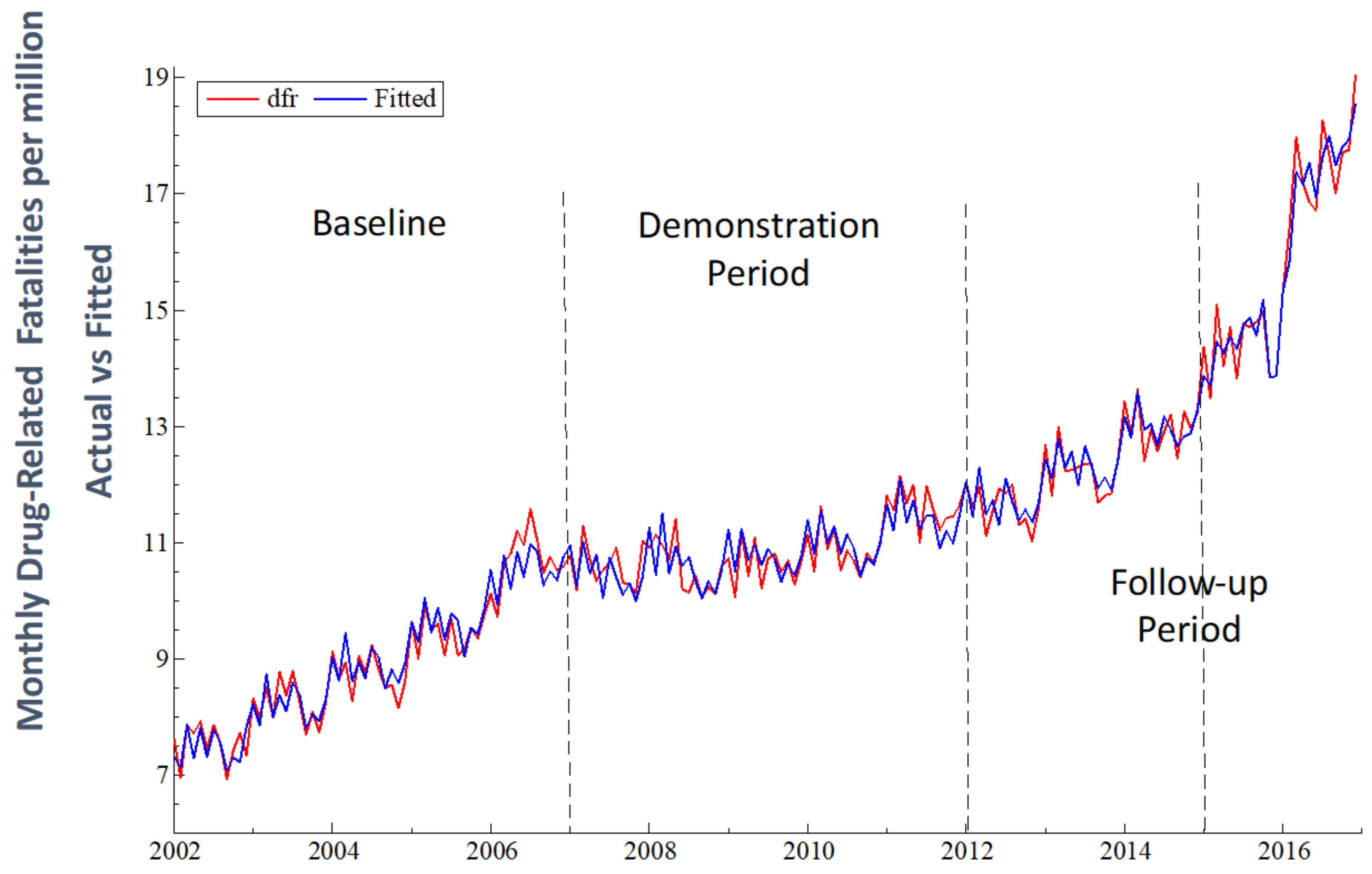
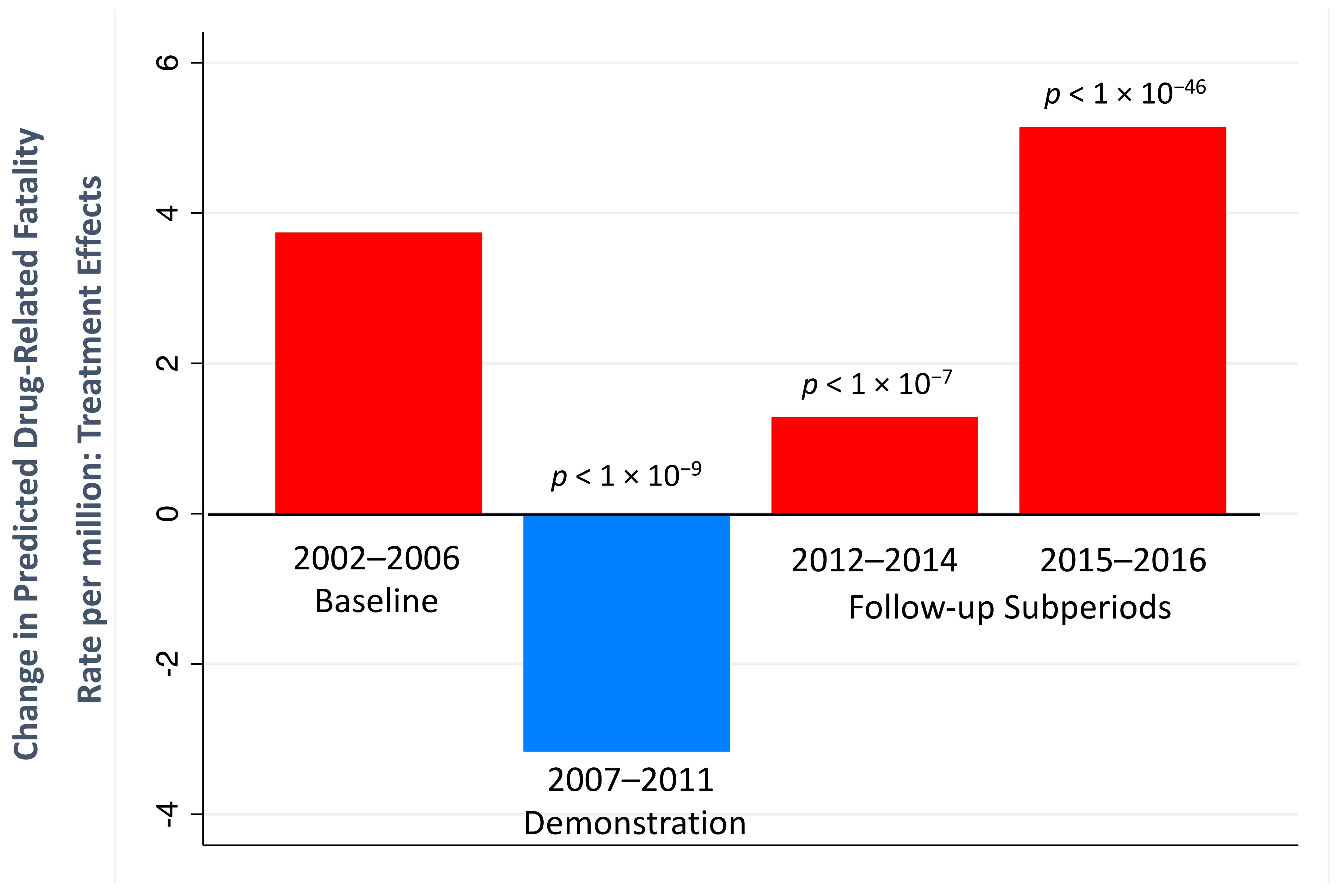
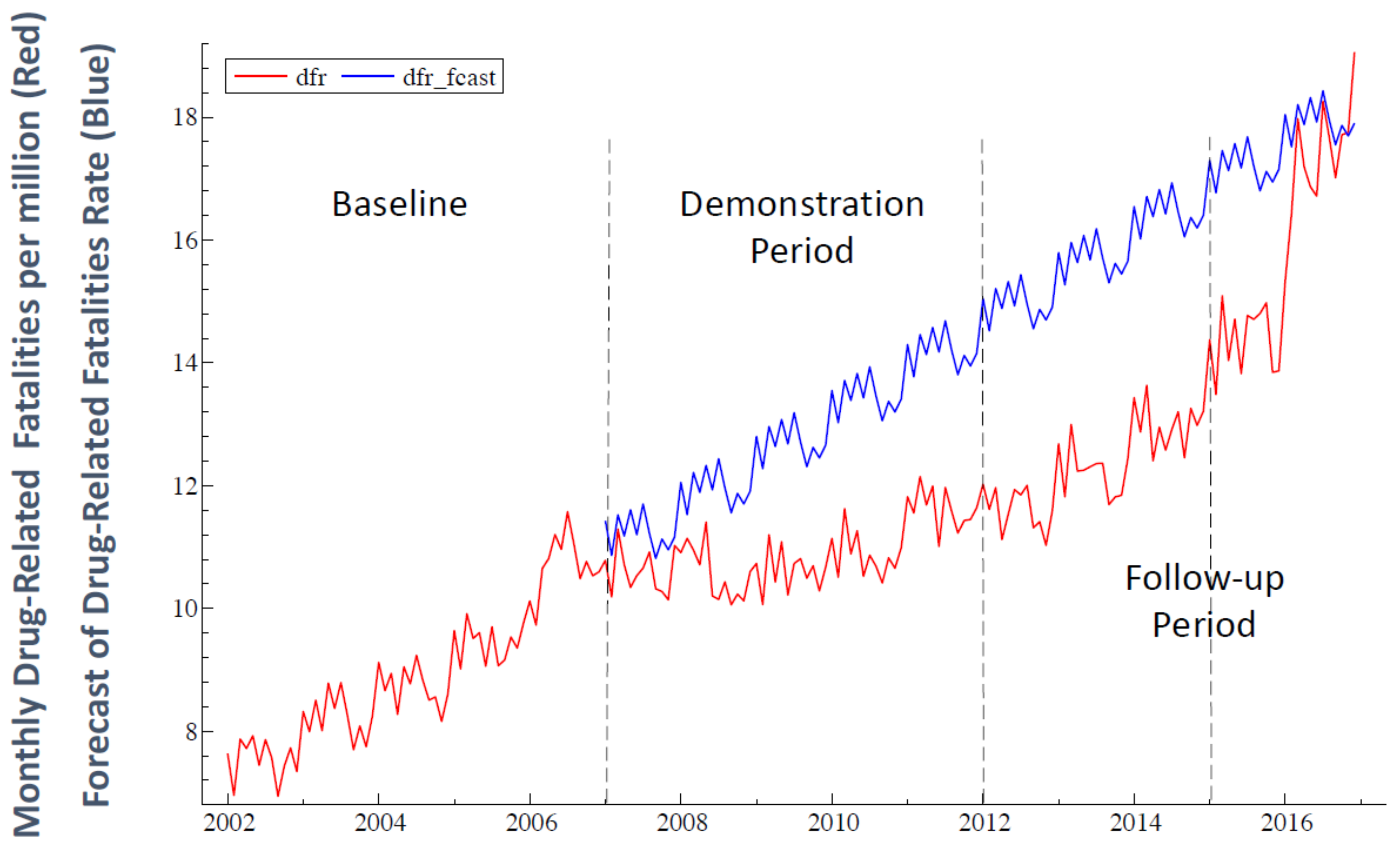
| Regression Coefficient | Coeffic. Estimate | Standard Error (SE) 1 | t-Ratio 2 |
|---|---|---|---|
| Constant term (β0) | 4.369 | 0.669 | 6.54 a |
| Lagged dep. variable (β1) | 0.388 | 0.091 | 4.25 a |
| Baseline trend (β2) | 0.038 | 0.005 | 7.18 a |
| Level shift Jan. 2007 (β3) | −0.358 | 0.148 | −2.42 d |
| Trend shift Jan. 2007 (β4) | −0.027 | 0.005 | −5.27 a |
| Trend shift 2012 (β6) | 0.022 | 0.007 | 3.42 b |
| Trend shift 2015 (β8) | 0.114 | 0.016 | 6.96 a |
| January seasonal (S1) | 0.489 | 0.128 | 3.82 b |
| February seasonal (S2) | −0.285 | 0.145 | −1.97 d |
| March seasonal (S3) | 0.676 | 0.133 | 5.09 a |
| April seasonal (S4) | −0.297 | 0.150 | −1.98 c |
| May seasonal (S5) | 0.241 | 0.115 | 2.10 c |
| June seasonal (S6) | −0.371 | 0.137 | −2.71 c |
| July seasonal (S7) | 0.237 | 0.121 | 1.96 |
| August seasonal (S8) | −0.161 | 0.120 | −1.34 |
| Sept. seasonal (S9) | −0.579 | 0.097 | −5.91 a |
| Oct. seasonal (S10) | −0.157 | 0.098 | −1.59 |
| Nov. seasonal (S11) | −0.455 | 0.109 | −4.19 a |
| Outlier Nov. 2015 | −1.250 | 0.088 | −14.30 a |
| Outlier Dec. 2015 | −1.391 | 0.164 | −8.50 a |
| Outlier Jan. 2016 | −0.577 | 0.206 | −2.81c |
| F-statistic: F(20, 159) = 536.30 (p < 0.001) | Mean (SD) of dfr = 11.166 (2.427) | ||
| Root MSE = 0.311 | R2 = 0.985; Adjusted R2 = 0.984 | ||
| Sum of squared residuals = 15.406 | Log-likelihood = −34.170 | ||
| AICc 3 = 118.787 | BIC 4 = 182.586 | ||
| Long-Run Equilibrium Coefficient (LR Multiplier) 1 | Coefficient Estimate | Standard Error (SE) 2 | t-Ratio 3 |
|---|---|---|---|
| Constant (b0) | 7.137 | 0.132 | 54.20 a |
| Baseline slope (b2) | 0.062 | 0.004 | 16.30 a |
| Level shift 2007 (b3) | −0.585 | 0.183 | −3.20 b |
| Trend shift 2007 (b4) | −0.044 | 0.005 | −8.87 a |
| Trend shift 2012 (b6) | 0.037 | 0.007 | 4.96 a |
| Trend shift 2015 (b8) | 0.187 | 0.015 | 12.50 a |
Disclaimer/Publisher’s Note: The statements, opinions and data contained in all publications are solely those of the individual author(s) and contributor(s) and not of MDPI and/or the editor(s). MDPI and/or the editor(s) disclaim responsibility for any injury to people or property resulting from any ideas, methods, instructions or products referred to in the content. |
© 2023 by the authors. Licensee MDPI, Basel, Switzerland. This article is an open access article distributed under the terms and conditions of the Creative Commons Attribution (CC BY) license (https://creativecommons.org/licenses/by/4.0/).
Share and Cite
Dillbeck, M.C.; Cavanaugh, K.L. Empirical Evaluation of the Possible Contribution of Group Practice of the Transcendental Meditation and TM-Sidhi Program to Reduction in Drug-Related Mortality. Medicina 2023, 59, 195. https://doi.org/10.3390/medicina59020195
Dillbeck MC, Cavanaugh KL. Empirical Evaluation of the Possible Contribution of Group Practice of the Transcendental Meditation and TM-Sidhi Program to Reduction in Drug-Related Mortality. Medicina. 2023; 59(2):195. https://doi.org/10.3390/medicina59020195
Chicago/Turabian StyleDillbeck, Michael C., and Kenneth L. Cavanaugh. 2023. "Empirical Evaluation of the Possible Contribution of Group Practice of the Transcendental Meditation and TM-Sidhi Program to Reduction in Drug-Related Mortality" Medicina 59, no. 2: 195. https://doi.org/10.3390/medicina59020195
APA StyleDillbeck, M. C., & Cavanaugh, K. L. (2023). Empirical Evaluation of the Possible Contribution of Group Practice of the Transcendental Meditation and TM-Sidhi Program to Reduction in Drug-Related Mortality. Medicina, 59(2), 195. https://doi.org/10.3390/medicina59020195





